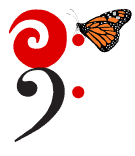Pachelbel’s Canon
Here is my overtone variation about the canon of Johann Pachelbel, in which I sing bass and soprano at the same time. It is an exercise for polyphonic overtone singing, which I once wrote for my students in the mid 1990s.
I have developed a series of preparatory exercises for my Masterclass students to build up the polyphonic singing skills step by step. It takes a whole weekend and a few weeks of practice. But if you want to try it out with the canon right away: Download the sheet music for free here.
It is a multitasking exercise that requires concentration. I sing two melodies contrapuntally. I lead the bass melody (ostinato) with my left hand and sing it first without overtone technique. Then I start the melody in the overtones and follow it with my right hand.
The left hand is linked to the right brain, where the perception of overtones is located. But it follows the basic melody, which is processed in the left brain. The right hand is controlled by the left hemisphere, but follows the overtones that are processed on the right side (see “How overtones work in the brain” and “Test: Are you an overtone or a fundamental listener?“).
In my experience, this crossover of hand control and auditory perception has an accelerating effect on learning and intonation gets better. If you occasionally swap hands, i. e. overtones on the left and fundamental tones on the right, this intensifies the training effect. But generally I recommend to practice the first version.
At the beginning you always have the problem that either the overtones don’t sound good or the keynote is completely out of tune. This is probably due to the fact that the brain can initially concentrate either on the clarity of the overtones or on the intonation of the fundamental tones. This multitasking is very similar to playing the piano, where the left hand plays the bass and the right hand the high part.
Try out which hand follows the overtones more easily and leave it in the comments. And whether you’re right or left-handed. I’d like to know if left-handed people are different.



Recent Comment